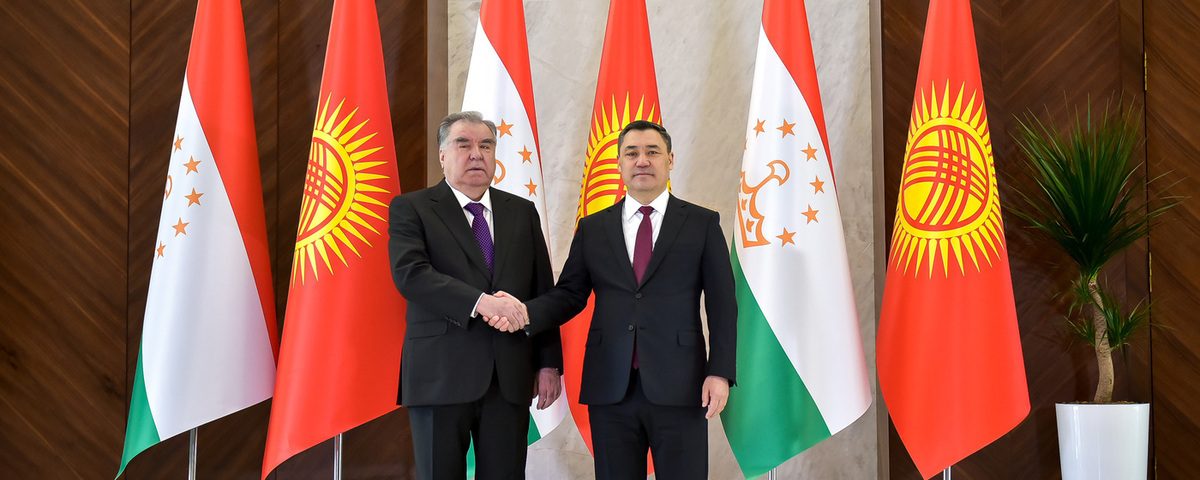The year 2025 was marked by a breakthrough development in Central Asia: on March 13, Kyrgyzstan and Tajikistan concluded a landmark border agreement. Later, on March 31, the presidents of Kyrgyzstan, Tajikistan, and Uzbekistan signed an agreement on the junction point of the three countries’ state borders, ending decades of border tensions in the Fergana Valley.
These achievements have indicated a pivotal shift in regional interaction dynamics. The previously undefined borders in the Fergana Valley have been a persistent source of contention and tension. While Uzbekistan had, in principle, reached agreements on its borders in the valley, unresolved border delimitation between Kyrgyzstan and Tajikistan remained a major point of dispute. Specifically, the 1,006.84 km-long border between Kyrgyzstan and Tajikistan has been a subject of contention since their independence. In 2011, 519 km of the border were agreed upon, and over the past three years, an additional 486 km have been determined—but the remaining sections were unresolved [Fergana Agency, 2025]. Therefore, the latest developments in border delimitation represent one of the long-awaited and significant achievements in Central Asian politics.
The Fergana Valley, one of the most densely populated and agriculturally productive areas of Central Asia, is divided among eastern Uzbekistan (approximately 60%), southern Kyrgyzstan (around 15%), and northern Tajikistan (about 25%). With about 15 million people, the valley accounts for approximately one-fifth of Central Asia’s total population and is the most densely populated part of the region. Thanks to its fertile land, nourished by the Syr Darya River and a vast irrigation system, Fergana serves as the backbone of local economies through the production of fruits, vegetables, and other agricultural products [Mendikulova and Beshimov, 2024].
However, the undefined political borders, a legacy of the Soviet era, which left a complex mosaic of borders, enclaves, and exclaves, have caused tensions and disputes over land, water, and access up to the present. It was rooted in the so-called national-territorial delimitation process initiated by Soviet authorities in the 1920s to conceptually transform the once multiethnic Turkestan, Bukharan, and Khivan republics into mono-national Soviet republics [Reeves, 2021]. Since the first formal delimitation, which took place between 1924 and 1936, the resolution of border issues in the Fergana Valley has remained a persistent challenge. In particular, continuing disagreements over borders and the use of land and water prompted the convening of joint, so-called Parity Commissions in 1958, 1959, 1986, 1987, and 1989 [Beishembiev, 2013]. Those commissions aimed to define the borders based on several principles: nationality, actual land use at the time of demarcation, economic feasibility, and the prevention of excessive territorial striping.
Despite these efforts, the collapse of the Soviet Union left the Fergana Valley with irregular borderlines and enclaves located within foreign territories. By the end of the Soviet era, there were four Uzbek enclaves within Kyrgyz territory—Sokh, Shakhimardan, Chon-Gara (Chon-Kara), and Tash-Tepa (Tash-Dobe)—as well as two Tajik enclaves: Vorukh and Kairagach (Western Kalacha). Within the territory of Uzbekistan, there was one Kyrgyz enclave (Barak) and one Tajik enclave (Sarvak or Sarvaksoy) [Alamanov, 2018].
After independence, borders became politically charged symbols, complicating water usage between upstream and downstream communities, politicizing access to pastures, grazing lands, roads, and waterways, and intensifying the securitization of everyday mobility [Reeves, 2021]. As a result, residents of the valley have faced recurring tensions over the past decades, driven by a combination of political, economic, security, and social challenges. Most skirmishes have involved ordinary residents and stemmed from disputes over shared access to water resources and pastureland.
While there were periods of relative calm, since 2019, the conflicts in the valley have become more frequent and severe. In particular, one of the bloodiest clashes occurred in the spring of 2021 along the Kyrgyz-Tajik border. It claimed 55 lives, left nearly 300 others injured to varying degrees, and resulted in the destruction of dozens of residential houses and other structures on both sides [Asia-Plus, 2021]. It further worsened during the conflict in September 2022, when around 100 people were killed and more than 150 residents were forced to flee their homes [Fergana Agency, 2025]. The escalation of border clashes led to significant difficulties for local people, resulting in the closure of border interactions, halting air and road connections, and even restricting border crossings. This directly impacted border trade, which is the primary source of livelihood for many there.
The settlement of disputed territories along the Kyrgyz-Tajik border was, therefore, essential for maintaining peace and stability in the valley. A major challenge to this process was the disagreement over which historical documents should serve as the basis for demarcation. The Kyrgyz Republic insisted on using documents from 1955–1959, while Tajikistan preferred maps from 1924–1927 [Azattyq, 2022].
According to the former head of the State Border Service of the Kyrgyz Republic, General Tokon Mamytov, the border negotiations between Kyrgyzstan and Tajikistan can be divided into three periods. The first border settlement efforts from 2002 to 2010 clarified the Chon-Alai district’s mountainous border. This period was marked by the absence of serious clashes, as the borders were being clarified. The second period (2012–2020), meanwhile, was more complicated, as the process of border clarification on the plains was met with conflicting interpretations from both sides. The third period, which began in 2020, proved to be even more challenging, marked not only by intensified border clashes but also by the use of heavy military equipment [Azattyq, 2022].
Recent progress on the border issue became possible when the governments agreed on two key principles: to make the documents and outcomes of negotiations public and to use both the 1991 maps and the current territorial realities of the countries as the basis for discussions [Azattyq Asia, 2025].
This approach ultimately led to the completion of the border delimitation in early December 2024. Following this, Kyrgyz President Sadyr Japarov and Tajik President Emomali Rahmon signed an agreement on the state border on March 13, 2025, during President Rahmon’s state visit to Bishkek. The final step in resolving the border issue came on March 31, 2025, when the two presidents participated in the signing ceremony of the Protocol on the Exchange of Instruments of Ratification in Khujand.
The settlement of the Kyrgyzstan–Tajikistan border was also important because it enabled progress in reaching border agreements with Uzbekistan in the valley. As a result, another key milestone was achieved on March 31, 2025 – the presidents of Kyrgyzstan, Tajikistan, and Uzbekistan concluded an agreement on the junction point of the three countries’ state borders.
In terms of border division, the Chairman of the State Committee for National Security of Kyrgyzstan, Kamchybek Tashiev, presented the details of the settlement during a session of the Jogorku Kenesh on February 27, 2025. According to Tashiev, the land exchange between Kyrgyzstan and Tajikistan was conducted on an equal basis, with each side receiving 190 hectares. Specifically, Kyrgyzstan received 155 hectares in the Kairagach area and 35 hectares within the Kairagach enclave. In return, Tajikistan received 190 hectares, including areas in Saada, Razzakov, Selkan, Maity, Proletarsk, Ak-Aryk, and Ulak-Zhay, along with the Dostuk market and the Khujand–Kanibadam/Arka highway [Fergana Agency, 2025].
In more detail, the most difficult area—the Vorukh enclave (Tajik)—was reduced from 19 thousand to 14.5 thousand hectares. The Kyrgyz side transferred 1,000 hectares around Vorukh to Dushanbe, receiving in return 1,000 hectares of Karagansay in the Chon-Alai district. In Batken and Isfara districts, the village of Dostuk was fully transferred to Tajikistan, as it held no strategic importance for Kyrgyzstan. In return, Kyrgyzstan received 91 hectares elsewhere, along with 30 hectares in the Lakkona area, where the residents of Dostuk are expected to be resettled. In the Golovnoy area, Kyrgyzstan received 150 hectares in Katta-Tuz in exchange for half of the disputed territory in Golovnoy. The Katta-Tuz area itself was divided evenly, 300 hectares for each side [Fergana Agency, 2025].
The water intake facility at Golovnoy was also split equally, with each country receiving 1.5 hatches. Furthermore, both governments agreed to allow free and mutual access to water management activities, regardless of whether the infrastructure lies in the other’s territory. Besides, to improve connectivity, both sides agreed to construct new roads along the Dacha–Kapchygai–Khojaluu–Vorukh and Min-Oruk–Samarkandek–Ariona–Shuriston routes, in addition to the existing Tort-Kocho Road. These roads are given neutral status, allowing residents of border villages to travel along them without formally crossing international borders [Fergana Agency, 2025].
Achieving these agreements required substantial coordination. Since the start of renewed negotiations in December 2022, the parties signed 45 protocols, convened 86 topographic groups, and established 25 legal working groups [Fergana Agency, 2025].
Meanwhile, Uzbekistan reevaluated and intensified its efforts on border delimitation following the inauguration of President Shavkat Mirziyoyev in 2016. Uzbekistan successfully finalized its shared borders with Kyrgyzstan in 2022 and advanced the border delimitation process with Tajikistan in 2018 [Gazeta.uz, 2022; CABAR.asia, 2021]. Hence, Uzbekistan was anticipating the resolution of the Kyrgyz-Tajik borders to finalize its border settlement.
The decades-long border disputes in the Fergana Valley, caused by a lack of consensus over border definitions, have finally been resolved. At the grassroots level, defined borders provide reassurance to local communities by eliminating uncertainty and reducing the risks of conflict and violence related to shared resources and infrastructure. It also ensures the free movement of people and cross-border trade and contributes to reinforcing the social and cultural cohesion of citizens. At the regional level, the formalized status of the Fergana Valley opens up significant opportunities for strengthening regional partnerships. By developing new road and air connections and facilitating the movement of people and goods, all regional partners have greater potential to deepen intraregional ties.
Central Asian leaders have managed a critical regional issue—an essential step toward ensuring peace and stability in the region. While the demarcation of borderlines remains a challenge for now, the positive political aspirations of the leaders offer hope that this process will be settled soon. The defined borders of the Fergana Valley are anticipated to promote the advancement and coherence of Central Asian ties.
References:
Alamanov, Salamat (2018). Enclaves in Central Asia: History of the Issue and Contemporary Problems. Post-Soviet Studies, vol.1, № 5, 2018, pp. 451–458.
Asia-Plus (2021). More than half a year has passed since the tragedy in Vorukh. What has changed? Retrieved from https://asiaplustj.info/ru/news/tajikistan/politics/20211202/bolshe-polugoda-proshlo-s-tragedii-v-voruhe-chto-izmenilos. Accessed on 08.04.2025.
Azattyq (2022). Kyrgyz-Tajik border: a chronology of conflicts. Retrieved from https://rus.azattyk.org/a/32063424.html. Accessed on 08.04.2025.
Azattyq Asia (2025). Kyrgyz-Tajik border: how land plots, roads and other objects were divided. Retrieved from https://rus.azattyk.org/a/kyrgyzsko-tadzhikskaya-granitsa-kak-podelili-uchastki-dorogi-i-drugie-obekty/33330138.html. Accessed on 08.04.2025.
Beishembiev E. J. Issues of delimitation and demarcation of the state border between Kyrgyzstan and Tajikistan (1920–2013). Bulletin of the Kyrgyz State Law Academy, № 2, 2013, pp. 7–10.
CABAR.asia (2021). How are negotiations on the border between Tajikistan and Uzbekistan being conducted? Retrieved from https://cabar.asia/en/?p=46356. Accessed on 08.04.2025.
Fergana Agency (2025). Tashiev listed the disputed territories that Kyrgyzstan and Tajikistan exchanged. Retrieved from https://fergana.agency/news/136808/. Accessed on 04.04.2025.
Gazeta.uz (2022). Deputies adopted laws on the border with Kyrgyzstan. What lands Uzbekistan gives up and receives. Retrieved from https://www.gazeta.uz/ru/2022/11/14/borders/. Accessed on 08.04.2025.
Mendikulova, Fatima and Beshimov, Baktybek (2024). Territorial disputes in Ferghana Valley. In: Gray, K.W. (eds) Global Encyclopedia of Territorial Rights. Springer, Cham.
Reeves, Madeleine (2021). Unsettled space. Unfinished histories of border delimitation in the Ferghana Valley. In Routledge Handbook of Contemporary Central Asia. Routledge.
Note: The views expressed in this blog are the author’s own and do not necessarily reflect the Institute’s editorial policy.

